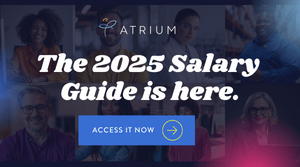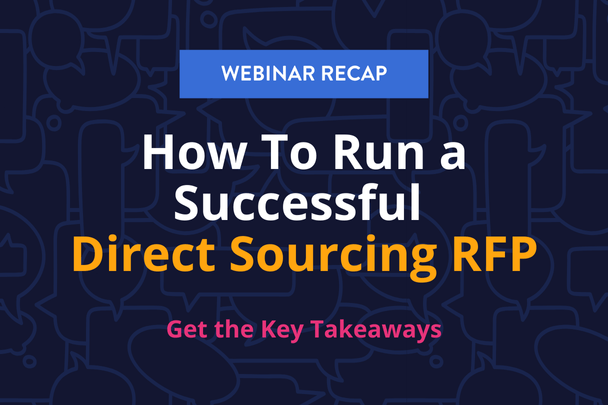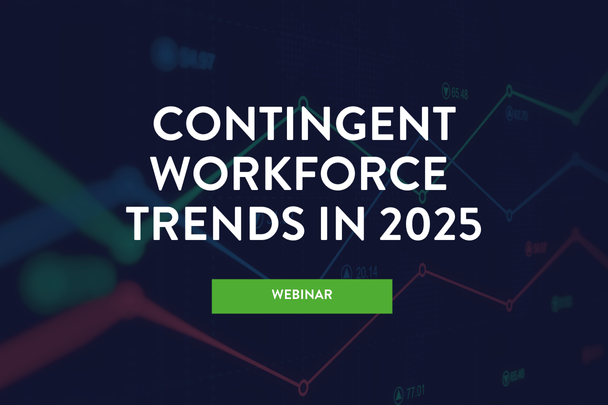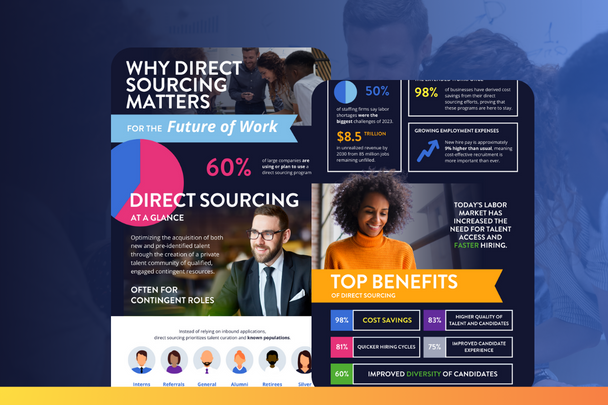ABOUT THIS EPISODE
Demystifying Direct Sourcing: A Conversation with TalentNet’s Justin Lumby
In the latest Atrium on Air episode, COO of TalentNet, Justin Lumby, joins host Brad Martin, CRO of Atrium, to demystify the concept of Direct Sourcing. They tackle definitions, debunk myths, and explore the evolution of Direct Sourcing. From the early trial-and-error phase to established best practices and KPIs, Justin and Brad walk us through the journey and share insights on how to achieve maximum ROI and other benefits through Direct Sourcing programs. Tune in to discover how to fully realize the potential of Direct Sourcing!
Recorded On: July 1, 2024
transcript
Welcome to Atrium on Air, where we deliver the latest insights and strategies for navigating the world of extended workforce solutions.
Join us as our expert guests share their experiences building successful extended workforce programs, leveraging the latest in talent technology and harnessing the potential of workforce data.
Start exploring the modern world of work today with Atrium on Air.
Welcome to Atrium on Air.
My name is Brad Martin, Atrium’s Chief Revenue Officer, and today I’ll be hosting the podcast.
I am joined today by Justin Lumby, who is TalentNet’s Chief Operating Officer. And today we’re going to have a dialogue about myths and misconceptions around direct sourcing and just generally how the concept of direct sourcing has evolved over the years.
Justin, it’s great to have you on the show today. Welcome.
Hey, Brad, thanks for having me. It’s a real pleasure.
So Justin, you’ve been with TalentNet for nearly a decade now. You’ve held lots of roles, tech strategy, you were Chief Product Officer, now your COO. You’ve really seen this concept of direct sourcing evolve over the years, haven’t you?
Yeah, absolutely, Brad. I think going back ten years ago, so if I reflect on my time at TalentNet and even really before that, my background previous to TalentNet was really in procurement and human resources within talent acquisition.
And originally there was sort of a basic, I guess, theory, if you will, that we could borrow many of the technology and even operational strategies that exist within talent acquisition and lend them to the contingent workforce world, domain.
But really back then it was a much more basic strategy. We were dealing with very basic technology and even basic operational best practices.
Since then, it’s really evolved both from a technical landscape, but I think as well in terms of the operations becoming more sophisticated, the way that they blend and marry up to MSP services and with the businesses and clients that they support.
And with that, we’ve seen more demand to support evolving and more sophisticated strategies and that’s led the technology to become more complex but more capable as well.
As we look forward, we really think this becomes sort of a bridge to, not to use a cliche, but perhaps total talent management, where again, because we’re borrowing many of these sort of strategies and technical ideas from talent acquisition, they blend nicely then with the full time talent acquisition world and really become an enabler for those large enterprise clients that are looking now to sort of blend together some of their contingent best practices with talent acquisition and create some beginning of a total talent strategy.
Justin, it’s interesting that you mentioned technology and services, certainly Atrium and TalentNet have partnered up on several enterprise programs quite successfully. To me, a holistic approach to direct sourcing really is multiple components.
You’ve got the technology component, you’ve got curation, payrolling, you’ve got workforce data intelligence, even value-add services on top of that, such as recruitment marketing. So to really look at it holistically, it’s multiple components.
But while it seems that the concept of direct sourcing has been around for quite some time, it still feels like depending on who you ask, you get a different definition these days.I think maybe that’s part of what leads to some of the misconceptions about what direct sourcing actually is.
So I’m curious, from your perspective, from TalentNet’s perspective, how would you define direct sourcing today?
I think that’s a very valid point. Maybe just before defining it. I think that a lot of that, I guess, difference of opinion or differences in definition. A lot of that I think, arises out of some of the early experimentation that was done with direct sourcing, before there really was establish best practices operationally and strategically, and before we had technology platforms that were sort of capable of supporting these strategies.
But from our perspective, defining direct sourcing is pretty simple and straightforward.
One, it’s a talent acquisition strategy generally within the contingent workforce domain that really focuses on using a large enterprises’ brand as a key tool for that talent acquisition.
That there is a technical solution similar to sort of a candidate relationship management system, or even similar to an applicant tracking system within full-time talent acquisition that is being leveraged within that sort of contingent domain.
And then you’ve got a sound operating strategy, which typically is referred to as a curator within this space and within direct sourcing. And that’s much more than maybe just sort of a streamlined recruitment service that’s sort of searching through a database or passively looking at job applicants. It really is a partner to the business and a capable operations and professional services company that’s capable with engaging with their customer and ultimately sort of being that brand ambassador, if you will, to that corporate brand.
And user adoption is so key. Helping everyone that touches a direct sourcing program, whether it’s a manager or the stakeholders of the program, helping them all understand even basic stuff like what we’re talking about right now: The definition of direct sourcing, what the program’s there to achieve.
These are core components that everybody needs to understand to drive the success of the program within an organization. If done correctly, direct sourcing really is the number one way to drive hard dollar cost savings within an extended workforce program. And so it’s so important to get this right even after the initial implementation.
Justin, there’s a lot of, I’d say, myths or misconceptions about direct sourcing, maybe even just misunderstandings in the marketplace just beyond the definition of it.
I’m curious, what are some of the things that you see in the marketplace that are some of these myths or misconceptions, whether that’s the cost to implement the program or just complexity of standing one up?
Yeah, I think there’s a number of myths, and I think you’ve touched on a couple of them there. So maybe I’ll just go with the second one you mentioned, and we can talk about a few more as well.
So one of them, I think, is around implementation and the perceived difficulty perhaps of implementing a direct sourcing program and getting it right. Because again, I guess to sort of acknowledge that and maybe where that belief comes from, you are typically implementing a technology stack and integrating that into an existing technical ecosystem. You’re implementing typically a new professional services partner in the form of a curation partner. So there are different aspects that you’re sort of trying to bring together and, and marry up.
But I think the perception of difficulty to implement and to get right, I really think that’s born out of early days in direct sourcing where again, there was a lot of experimenting going on today, both from a technical perspective and the roadmap to implement.
I mean, that is a tried, tested and true process. Now, not to say anything is ever rinse and repeat. There’s always nuances to it, but certainly something where it’s a well-established process. And the same goes, and I would even say it’s in some ways is more important, is the implementation of the operational strategy behind that.
And again, in early days, a lot of experimentation going on and I think that led to confusion and it led to a perception of this is very difficult to get right, but now we have very established best practices. And not only that, but data KPIs that sort of back that, back that up.
Where new enterprises that are looking at implementing this now, they can look at other peer enterprises across different industry verticals and really understand what they got right and how they got it right.
I do think it’s important, though, to work with a capable partner, one that has particular experience in this space when implementing. So you’re not sort of going through and sort of repeating that, I guess that period of experimentation.
You know, it feels like one of the core tenets, the core components of direct sourcing, it always comes up every time we’re talking about it, is the concept of a client leveraging the power of their brand to create these talent pools, these strong talent communities, particularly with brands that have a lot of brand equity, some of these large brands that tend to launch big direct sourcing programs.
I’m curious, in addition to leveraging their brand, what are some of the other ways that you would suggest a company go about helping to build a really strong talent community, or would you like to expand upon the power of the brand concept?
Yeah, I think the brand component is really important, but what I’ll touch on is sometimes maybe another myth or misconception is that direct sourcing is a passive strategy or a relatively passive strategy.
I’m going to implement this technology stack.
I’m going to have a white-labeled talent community or portal, if you will, that active talent can engage with.
And I’m just going to start sort of engaging talent and sort of bringing them on.
And it’s going to be that simple.
And not to say direct sourcing necessarily is complex in its execution, but it is really important, again, that role of curation, that sort of operational role, that brand ambassador role, that is a very active role both internally within the organization.
So socializing the idea that you have a direct sourcing program, socializing the benefits within the organization of what that can then provide back to various business units in terms of, as you say, real hard dollar cost savings.
But it’s also the much broader socialization externally to the market.
What you’re really trying to do is create a viral effect where as you develop a larger and larger talent pool, as you have more engagement through it, you’re almost trying to create
a bit of an echo chamber now where all of that sort of active talent that’s come through this channel that’s very sort of user friendly to them.
They felt that they had a brand ambassador sort of as a custodian to them through the process, and using that, again to sort of amplify the word, if you will, or really push that socialization out.
And that is a key role of a curator that goes far beyond just simply branding a talent community or posting jobs to, you know, social media or job board.
Right.
It’s leveraging all these different channels to, you know, to help fill the talent pool, whether it’s manager referrals or silver medalists that you’re inviting into the, to the talent pool or retirees coming back into the workforce, or again, leveraging the power of your brand.
It’s all these different channels that you are using to help curate your talent pool.
So it hits this tipping point where suddenly it’s useful for the managers and that’s where program adoption really begins to take off. I’d imagine without the proper mechanisms in place to help fill the talent pool, it becomes extremely challenging.
Yeah, I completely agree.
And a talent pool in many ways it’s a living, breathing thing. It is something that is rich in data, which I think is a huge benefit in terms of historical engagement trends.
Have we engaged this person in the past?
What do we know about them?
How successful were they in previous jobs or assignments?
But that doesn’t just happen on its own. Again, it’s really important that that curation partner is active and living in that talent community as well, like any other database or anything else.
Of course, if it’s not being actively managed, you’re just not going to see the ROI and the maximum benefit that you can over time. Right.
Any other thoughts on how a company might optimize their direct sourcing strategy and program?
I think again, I would say the two really key aspects that we see in some of our most successful customers.
One again is that really capable curation partner and typically one that has previous experience doing this. Not to say that other organizations aren’t evolving and sort of coming into this space, but it’s really going to help if you’ve not done this before, to have a capable partner who sort of understands best practices.
And again, the second piece that I mentioned before I think is sometimes we see a lack of socialization within the enterprise.
There’s no understanding of A. That this program even exists, that this is a viable channel for me to engage labor, but also the benefits sort of to me as a business unit and what I’m able to be provided.
So I think if you can nail those two things, you’re really going to sort of amplify the ROI that you have over time.
Well, Justin, appreciate you joining the podcast today. You know, we had a brief chat, but I think we hit on some pretty important topics around direct sourcing. Hopefully some of this helped to demystify some of these concepts for our audience. Would love it if you’d stop by at a future time to join the podcast again and dive even deeper into some of these topics.
I’d love to. Brad, thanks again for having me on.
——–
This has been Atrium on Air, a podcast sponsored by Atrium. For additional information about Atrium’s talent and workforce management solutions, please visit www.atriumglobal.com.















